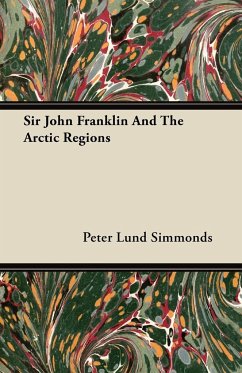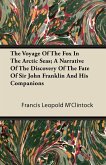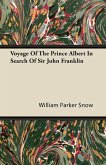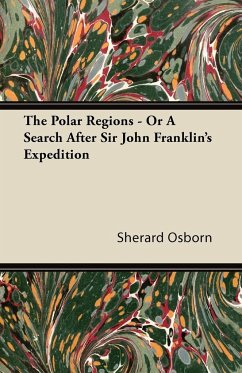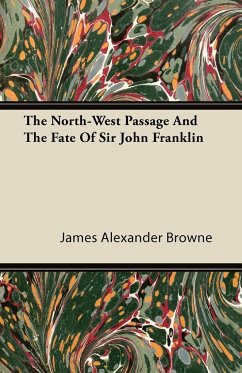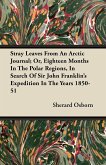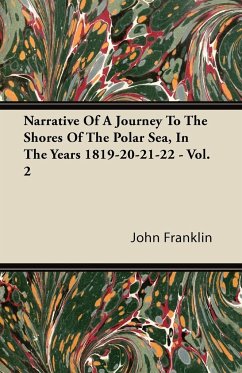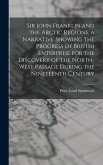Peter Lund Simmonds
Sir John Franklin and the Arctic Regions
Peter Lund Simmonds
Sir John Franklin and the Arctic Regions
- Broschiertes Buch
- Merkliste
- Auf die Merkliste
- Bewerten Bewerten
- Teilen
- Produkt teilen
- Produkterinnerung
- Produkterinnerung
John Franklin (1786-1847) was a famous Arctic explorer that sailed to find the North-West Passage. Becoming a haunting tale of history now known as Franklin's lost expedition. Franklin and his crew were last seen by whalers in Baffin Bay in July 1845. Many rescue missions were launched thereafter to find the lost ships, HMS Terror and Erebus. This gripping book written by Peter Lund Simmonds (1814-1897) uses a wide range of reports and publications about these expeditions in his history of the search for the North-West Passage. This detailed account also includes descriptions of the many…mehr
Andere Kunden interessierten sich auch für
![In the Arctic Seas - A Narrative of the Discovery of the Fate of Sir John Franklin and his Companions In the Arctic Seas - A Narrative of the Discovery of the Fate of Sir John Franklin and his Companions]() Francis Leopold McclintockIn the Arctic Seas - A Narrative of the Discovery of the Fate of Sir John Franklin and his Companions28,99 €
Francis Leopold McclintockIn the Arctic Seas - A Narrative of the Discovery of the Fate of Sir John Franklin and his Companions28,99 €![Voyage of the Prince Albert in Search of Sir John Franklin Voyage of the Prince Albert in Search of Sir John Franklin]() William Parker SnowVoyage of the Prince Albert in Search of Sir John Franklin34,99 €
William Parker SnowVoyage of the Prince Albert in Search of Sir John Franklin34,99 €![The Polar Regions - or, A Search After Sir John Franklin's Expedition The Polar Regions - or, A Search After Sir John Franklin's Expedition]() Sherard OsbornThe Polar Regions - or, A Search After Sir John Franklin's Expedition29,99 €
Sherard OsbornThe Polar Regions - or, A Search After Sir John Franklin's Expedition29,99 €![The North-West Passage and the Fate of Sir John Franklin The North-West Passage and the Fate of Sir John Franklin]() James Alexander BrowneThe North-West Passage and the Fate of Sir John Franklin27,99 €
James Alexander BrowneThe North-West Passage and the Fate of Sir John Franklin27,99 €![Stray Leaves from an Arctic Journal - or, Eighteen Months in the Polar Regions, in Search of Sir John Franklin's Expedition Stray Leaves from an Arctic Journal - or, Eighteen Months in the Polar Regions, in Search of Sir John Franklin's Expedition]() Sherard OsbornStray Leaves from an Arctic Journal - or, Eighteen Months in the Polar Regions, in Search of Sir John Franklin's Expedition21,99 €
Sherard OsbornStray Leaves from an Arctic Journal - or, Eighteen Months in the Polar Regions, in Search of Sir John Franklin's Expedition21,99 €![Narrative of a Journey to the Shores of the Polar Sea- In the Years 1819-20-21-22 - The Complete Edition Narrative of a Journey to the Shores of the Polar Sea- In the Years 1819-20-21-22 - The Complete Edition]() John FranklinNarrative of a Journey to the Shores of the Polar Sea- In the Years 1819-20-21-22 - The Complete Edition31,99 €
John FranklinNarrative of a Journey to the Shores of the Polar Sea- In the Years 1819-20-21-22 - The Complete Edition31,99 €![Sir John Franklin and the Arctic Regions, a Narrative Showing the Progress of British Enterprise for the Discovery of the North-West Passage During th Sir John Franklin and the Arctic Regions, a Narrative Showing the Progress of British Enterprise for the Discovery of the North-West Passage During th]() Peter Lund SimmondsSir John Franklin and the Arctic Regions, a Narrative Showing the Progress of British Enterprise for the Discovery of the North-West Passage During th41,99 €
Peter Lund SimmondsSir John Franklin and the Arctic Regions, a Narrative Showing the Progress of British Enterprise for the Discovery of the North-West Passage During th41,99 €-
-
-
John Franklin (1786-1847) was a famous Arctic explorer that sailed to find the North-West Passage. Becoming a haunting tale of history now known as Franklin's lost expedition. Franklin and his crew were last seen by whalers in Baffin Bay in July 1845. Many rescue missions were launched thereafter to find the lost ships, HMS Terror and Erebus. This gripping book written by Peter Lund Simmonds (1814-1897) uses a wide range of reports and publications about these expeditions in his history of the search for the North-West Passage. This detailed account also includes descriptions of the many missions to find Franklin and his crew and investigates the fate of Franklin's voyage.
Produktdetails
- Produktdetails
- Verlag: Read & Co. History
- Seitenzahl: 422
- Erscheinungstermin: 21. Juli 2011
- Englisch
- Abmessung: 216mm x 140mm x 25mm
- Gewicht: 592g
- ISBN-13: 9781446078815
- ISBN-10: 1446078817
- Artikelnr.: 33938779
- Verlag: Read & Co. History
- Seitenzahl: 422
- Erscheinungstermin: 21. Juli 2011
- Englisch
- Abmessung: 216mm x 140mm x 25mm
- Gewicht: 592g
- ISBN-13: 9781446078815
- ISBN-10: 1446078817
- Artikelnr.: 33938779
Peter Lund Simmonds, a prolific 19th-century writer and editor, authored the noteworthy work "The Curiosities of Food: Or, The Dainties and Delicacies of Different Nations Obtained from the Animal Kingdom." Simmonds became an English author, agriculturalist, and advocate for technological advancements in agriculture in the course of the Victorian era. In his masterful book, "The Curiosities of Food," Simmonds explores the fascinating and diverse global of culinary delights from diverse cultures. The subtitle, "Or The Dainties And Delicacies Of Different Nations Obtained From The Animal Kingdom," guidelines at the focal point at the animal nation as a source of diverse and uncommon ingredients. Simmonds in all likelihood takes readers on a gastronomic journey, detailing specific and curious culinary practices, elements, and dishes from around the globe. The book may delve into the ancient, cultural, and medical factors of meals, offering insights into the ways specific societies have harnessed the bounty of the animal country for sustenance and satisfaction. Simmonds, recognized for his know-how in agricultural and culinary topics, may additionally have infused the book with a blend of clinical inquiry and an appreciation for the wealthy tapestry of world food traditions.
Preface; Introductory remarks; Captain John Ross's voyage in the Isabella and Alexander to Hudson's Bay in 1818; Voyage of Buchan and Franklin in the Dorothea and Trent to Spitzbergen
etc.
1818; Franklin's first land expedition
1819-21; Parry's first voyage in the Hecla and Griper
1819-20; Parry's second voyage in the Fury and Hecla
1821-3; Clavering's voyage to Spitzbergen and Greenland in the Griper
1823; Lyon's voyage in the Griper
1824; Parry's third voyage in the Hecla and Fury
1824-5; Franklin's second land expedition
1825-6; Captain Beechey's voyage to Behring Strait in the Blossom
1826-8; Parry's fourth or Polar voyage in the Hecla
1827; Captain John Ross's second voyage in the Victory
1829-33; Captain Back's land journey in search of Ross
1833-5; Back's voyage in the Terror up Hudson's Strait
1836; Messrs. Dease and Simpson's discoveries on the coast of Arctic America
1836-9; Dr. John Rae's land expedition
1846-7; Captain Sir John Franklin's last expedition in the Erebus and Terror
1845-51; The government and private searching expeditions; Voyage of the Enterprise and Investigator under Captains Sir J. C. Ross and E. J. Bird
1848-9; Voyage of the transport
North Star
1849; Second voyage of the Enterprise and Investigator under Captain Collinson and Commander McClure
1850; Voyage of the Plover
and boat expeditions under Commander Pullen
1848-51; Voyage of the Lady Franklin and Sophia
purchased government ships
under the command of Mr. Penny; Voyage of the Resolute and Assistance
under command of Captain Austin
with their steam tenders
Pioneer and Intrepid
1850-1; Voyage of Captain Sir John Ross in the Felix private schooner
1850-1; American government searching expedition in the US ships Advance and Rescue
under the command of Lieutenant de Haven
1850-1; Remarkable voyage of the private ship
Prince Albert
under the command of Captain Forsyth
R.N.
to Regent Inlet and back
1850; Appendix.
etc.
1818; Franklin's first land expedition
1819-21; Parry's first voyage in the Hecla and Griper
1819-20; Parry's second voyage in the Fury and Hecla
1821-3; Clavering's voyage to Spitzbergen and Greenland in the Griper
1823; Lyon's voyage in the Griper
1824; Parry's third voyage in the Hecla and Fury
1824-5; Franklin's second land expedition
1825-6; Captain Beechey's voyage to Behring Strait in the Blossom
1826-8; Parry's fourth or Polar voyage in the Hecla
1827; Captain John Ross's second voyage in the Victory
1829-33; Captain Back's land journey in search of Ross
1833-5; Back's voyage in the Terror up Hudson's Strait
1836; Messrs. Dease and Simpson's discoveries on the coast of Arctic America
1836-9; Dr. John Rae's land expedition
1846-7; Captain Sir John Franklin's last expedition in the Erebus and Terror
1845-51; The government and private searching expeditions; Voyage of the Enterprise and Investigator under Captains Sir J. C. Ross and E. J. Bird
1848-9; Voyage of the transport
North Star
1849; Second voyage of the Enterprise and Investigator under Captain Collinson and Commander McClure
1850; Voyage of the Plover
and boat expeditions under Commander Pullen
1848-51; Voyage of the Lady Franklin and Sophia
purchased government ships
under the command of Mr. Penny; Voyage of the Resolute and Assistance
under command of Captain Austin
with their steam tenders
Pioneer and Intrepid
1850-1; Voyage of Captain Sir John Ross in the Felix private schooner
1850-1; American government searching expedition in the US ships Advance and Rescue
under the command of Lieutenant de Haven
1850-1; Remarkable voyage of the private ship
Prince Albert
under the command of Captain Forsyth
R.N.
to Regent Inlet and back
1850; Appendix.
Preface; Introductory remarks; Captain John Ross's voyage in the Isabella and Alexander to Hudson's Bay in 1818; Voyage of Buchan and Franklin in the Dorothea and Trent to Spitzbergen
etc.
1818; Franklin's first land expedition
1819-21; Parry's first voyage in the Hecla and Griper
1819-20; Parry's second voyage in the Fury and Hecla
1821-3; Clavering's voyage to Spitzbergen and Greenland in the Griper
1823; Lyon's voyage in the Griper
1824; Parry's third voyage in the Hecla and Fury
1824-5; Franklin's second land expedition
1825-6; Captain Beechey's voyage to Behring Strait in the Blossom
1826-8; Parry's fourth or Polar voyage in the Hecla
1827; Captain John Ross's second voyage in the Victory
1829-33; Captain Back's land journey in search of Ross
1833-5; Back's voyage in the Terror up Hudson's Strait
1836; Messrs. Dease and Simpson's discoveries on the coast of Arctic America
1836-9; Dr. John Rae's land expedition
1846-7; Captain Sir John Franklin's last expedition in the Erebus and Terror
1845-51; The government and private searching expeditions; Voyage of the Enterprise and Investigator under Captains Sir J. C. Ross and E. J. Bird
1848-9; Voyage of the transport
North Star
1849; Second voyage of the Enterprise and Investigator under Captain Collinson and Commander McClure
1850; Voyage of the Plover
and boat expeditions under Commander Pullen
1848-51; Voyage of the Lady Franklin and Sophia
purchased government ships
under the command of Mr. Penny; Voyage of the Resolute and Assistance
under command of Captain Austin
with their steam tenders
Pioneer and Intrepid
1850-1; Voyage of Captain Sir John Ross in the Felix private schooner
1850-1; American government searching expedition in the US ships Advance and Rescue
under the command of Lieutenant de Haven
1850-1; Remarkable voyage of the private ship
Prince Albert
under the command of Captain Forsyth
R.N.
to Regent Inlet and back
1850; Appendix.
etc.
1818; Franklin's first land expedition
1819-21; Parry's first voyage in the Hecla and Griper
1819-20; Parry's second voyage in the Fury and Hecla
1821-3; Clavering's voyage to Spitzbergen and Greenland in the Griper
1823; Lyon's voyage in the Griper
1824; Parry's third voyage in the Hecla and Fury
1824-5; Franklin's second land expedition
1825-6; Captain Beechey's voyage to Behring Strait in the Blossom
1826-8; Parry's fourth or Polar voyage in the Hecla
1827; Captain John Ross's second voyage in the Victory
1829-33; Captain Back's land journey in search of Ross
1833-5; Back's voyage in the Terror up Hudson's Strait
1836; Messrs. Dease and Simpson's discoveries on the coast of Arctic America
1836-9; Dr. John Rae's land expedition
1846-7; Captain Sir John Franklin's last expedition in the Erebus and Terror
1845-51; The government and private searching expeditions; Voyage of the Enterprise and Investigator under Captains Sir J. C. Ross and E. J. Bird
1848-9; Voyage of the transport
North Star
1849; Second voyage of the Enterprise and Investigator under Captain Collinson and Commander McClure
1850; Voyage of the Plover
and boat expeditions under Commander Pullen
1848-51; Voyage of the Lady Franklin and Sophia
purchased government ships
under the command of Mr. Penny; Voyage of the Resolute and Assistance
under command of Captain Austin
with their steam tenders
Pioneer and Intrepid
1850-1; Voyage of Captain Sir John Ross in the Felix private schooner
1850-1; American government searching expedition in the US ships Advance and Rescue
under the command of Lieutenant de Haven
1850-1; Remarkable voyage of the private ship
Prince Albert
under the command of Captain Forsyth
R.N.
to Regent Inlet and back
1850; Appendix.

